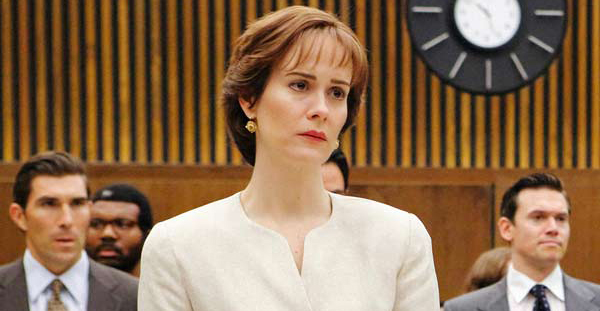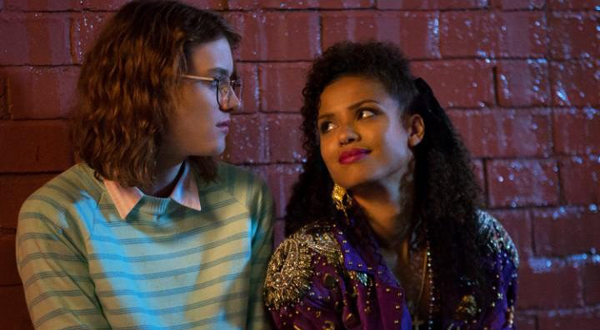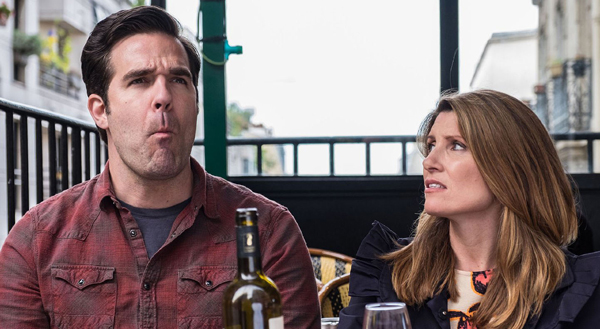
The Top Twenty Episodes of TV in 2016 — Part Three!
My list of my Twenty Favorite Episodes of TV in 2016 continues! Click here for the beginning of my list, numbers twenty through sixteen, and click here for part two, numbers fifteen through ten.
Let’s continue as we enter my Top Ten!
10. The People v. O.J. Simpson: American Crime Story: “Marcia, Marcia, Marcia” (season one, episode six, aired on 3/8/16) – I vividly remember the events of the O.J. trial, and at first the idea of a TV dramatization of those events didn’t hold much appeal for me, but like everyone else I was blown away by the riveting ten-episode The People v. O.J. Simpson. I was incredibly impressed with the way the show humanized so many of the men and women involved in the trial, even those who at the time I saw as villains or cartoons. The show’s greatest triumph was its complete redemption of losing prosecutor Marcia Clarke, who was brutalized by the media and much of the public at the time. This incredible episode of the show shines a spotlight on this particular issue, showing the many ways in which Ms. Clarke was run through the public ringer as she attempted to prosecute the case. The show, and this episode, hold out Ms. Clarke as a hero, someone attempting to navigate the impossible collision of prosecuting a hugely public case while also attempting to maintain a private life and be a mom to her kids, all the while going through a nasty divorce (and the way that divorce was thrust into the public eye), as well as incredible sexism and judgments about her appearance (her outfits, her hairstyle) made by the general public and colleagues alike. We see Ms. Clarke forced to grin and bear snide comments not only from Judge Lance Ito but even a nameless check-out clerk when she’s buying tampons. It’s heartbreaking. This performance was a triumph by Sarah Paulson, who was able to bring Ms. Clarke to life with enormous dignity and grace, and who with just a tiny movement or look could bring the audience right into Ms. Clarke’s heart and mind.
9. Black Mirror: “San Junipero” (season three, episode four, released on 10/21/16) – I rejoiced that Black Mirror, Charlie Brooker’s marvelous British anthology series exploring the dangers of technology, was resurrected by Netflix for a third season. This new season didn’t wind up matching the greatness of the first two seasons, but one standout was this episode, “San Junipero.” In the 1980′s, we follow the gentle story of the flowering relationship between Yorkie (The Martian‘s Mackenzie Davis), a tentative young woman first taking ownership of the idea that she is a lesbian, and Kelly (Gugu Mbatha-Raw), a friendly and outgoing bisexual party girl. This is a gorgeous story, one that strikes an unusually sweet tone for Black Mirror and even — shockers!! — has a (mostly) happy ending!! This is a beautiful episode, and a wonderful example of how expansive Black Mirror’s anthology structure can be. I was not expecting an episode like this, and so I was delighted by the surprise. Both Ms. Davis and Ms. Mbatha-Raw are wonderful, endearing and with a depth of character that you discover as the episode unfolds. I loved the charisma between the two, and the gentle way we watch their relationship blossom while also peeling back the onion of their individual back-stories. And the ending is wonderfully enigmatic and thought provoking — at first glance it feels happy, but there’s also something frightening about the idea of an eternity of togetherness. This was a beautiful story even without the eventual sci-fi twist. (Click here for my full review of Black Mirror season three.)
8. Catastrophe: “Episode 3” (season two, episode three, released on 04/16) – Holy cow do I adore this raunchy, hilarious British show (brought to the US by Amazon), written by and starring Sharon Horgan and Rob Delaney. The first season chronicled the first year of their relationship, from their initial drunken hookup to moments before the birth of their first child. The second season jumped ahead a few years, showing us their struggles to raise their now two kids and also somehow find personal and professional happiness along the way. This third episode was a particular stand-out, in which, after an argument over “sexual rainchecks” (which Rob categorizes as “abusive”), Sharon and Rob take their first real getaway together since becoming parents, heading to Paris for a romantic weekend. They hit a few bumps along the way, though, such as the fallout when Sharon realizes she’s forgotten to bring along her breast-pump. This is such a real, human scenario and yet I don’t think it’s one I have ever before seen on TV!! (In a spectacular bit of next-level Catastrophe raunchiness, Rob then offers to take the place of their baby Muireann — and I laugh even while typing that name; the show makes a full comedy meal out of its being impossible to pronounce — by sucking the milk out of Sharon’s breasts, commenting: “at least I won’t shit myself when I do it.”) The massage/groping misunderstanding is a bit more of a TV-exaggerated sort of situation, but it’s also very funny (and also uncomfortable and awkward, a line the show loves to walk). This show is not for everyone, but I found it to be one of the most unique, fall-on-the-floor funny shows I saw all year. (Click here for my full review of Catastrophe season two.)
7. O.J.: Made in America: “Part Two” (episode two, aired on 6/14/16) – Immediately after watching the magnificent The People v. O.J. Simpson: American Crime Story, I went on to watch Ezra Edelman’s ten-hour documentary on O.J. Simpson, O.J.: Made in America, which I actually found even more engrossing than The People v. O.J.! The first episode was great, a deep, deep dive into the early years of O.J. Simpson, but “Part Two” was a true master-class in documentary filmmaking that made clear the true purpose of this project: to chronicle the years of abuse (both real and perceived) of the African-American community by the L.A.P.D. (Los Angeles Police Department). Of course I knew of the Rodney King beatings (and the eventual acquittal of the police officers responsible), but “Part Two” also explores the shooting of Eula Love on her front lawn in 1979 and the shooting of young Latasha Harlins by a Korean grocer in 1991, as well as 1987’s “Operation Hammer” and the accompanying arrests of thousands of African-Americans, and also the accusations of racism against L.A.P.D. Daryl Gates, among other incidents. “Part Two” almost spends more of its run-time on these events than it does on the life of O.J. Simpson. In so doing, this episode, and this series, finally began to allow me to understand something that has long-since perplexed me: how so many African-Americans at the time were able to ignore the mountain of evidence against O.J. in their fervent belief that he was innocent. Made in America presents a tough-to-watch history of terrible transgressions made by the L.A.P.D. against the African-American community, and in so doing allows one to begin to understand how so many people came to believe, deep in their hearts, that the L.A.P.D. would never, ever, ever give a fare shake to a black person. This is the racial divide that burst out into the public arena during the spectacle of the O.J. trial, and this is the racial divide that is still so prominent across the U.S. today, though some would choose to deny it. O.J.: Made in America is important television. I wish it wasn’t still so relevant.
6. The Americans: “The Rat” (season four, episode six, aired on 4/20/16) – “I think Martha’s bad.” The best season ever of The Americans, about a family of Russian spies living in the U.S. in the eighties, peaked during this incredible hour of television in which everything came to a head with Philip’s fake marriage to Martha. This story-line — Philip’s relationship with and eventual marriage to Martha Hanson, begun in order to allow him access to the sensitive information she knew as secretary to FBI Supervisor Frank Gaad — had been present in the show since the very beginning. Back in season one, I’d expected this to get wrapped up fairly quickly, because how could Philip possibly sustain the charade? And yet, he did, for four seasons, growing ever closer to his mark, now wife, Martha, even as the screws began to tighten on them both. In this hugely satisfying episode, Stan Beeman and Dennis Anderholt finally put the pieces together about Martha, forcing Philip to put all his cards on the table, revealing the truth to Martha about his marriage to the woman who Martha thought was his sister, while Oleg and Tatiana make plans for Martha’s secret extradition to Russia. The scene in which Stan and Anderholt break the news about Martha to Gaad (and his response: “that’s… crazy”) was extraordinary, but the drama of that was dwarfed by the nail-biting cliffhanger in which Martha walked boldly out of the safehouse and away from Gabriel (Frank Langella), an action that seemed certain to spell doom not only for her, but also for Philip and Elizabeth. Alison Wright, who plays Martha, has been a solid support player on this show since the beginning, and it was wonderful that the show finally allowed her (and her character of Martha) to be given the spotlight. Ms. Wright crushed it. This was an incredibly tense, enormously well-crafted episode of one of the best shows that not nearly enough people are watching. (Click here for my full review of The Americans season four.)
I hope you’ll join me back here on Friday for my Top Five!




